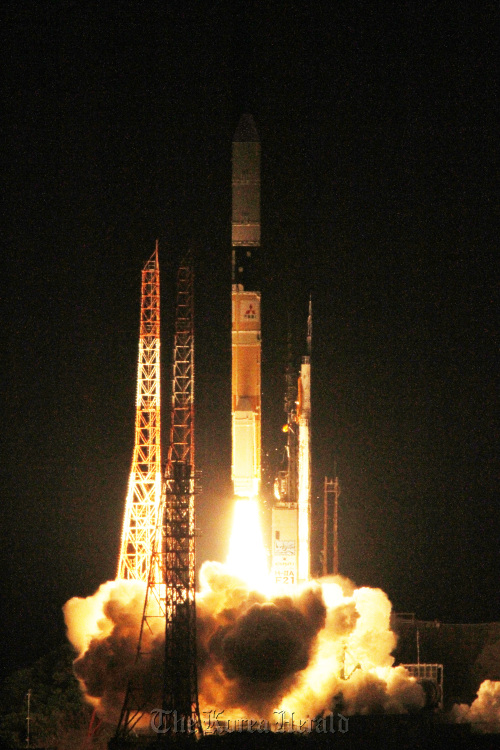
Korea made progress in its commercial space program by launching its third Earth observation satellite from a Japanese space center on Friday.
The KOMPSAT-3, also called the Arirang-3, lifted off aboard the Japanese H-2A rocket at 1:39 a.m. from the Tanegashima Space Center on an island some 115 kilometers south of Kyushu.
The satellite was separated from the rocket and went into orbit 16 minutes after launch and sent its first signal to a ground station in Antarctica at 2:18 a.m.
The satellite exchanged signals with the Korea Aerospace Research Institute in Daejeon around 3 a.m., indicating that it has entered the correct trajectory.
The successful launch is an important step in developing its commercial space program, according to the Ministry of Education, Science and Technology.
The Arirang-3 is the country’s first satellite with a “sub-meter” resolution camera. The multispectral device can distinguish a 0.7-meter object on Earth, a significant improvement from the Arirang-2 launched in 2006.
Currently, only the United States, Israel and the European Union have commercial satellites with that level of accuracy.
Global sales of Earth observation data reached more than $1.3 billion in 2010, and is expected to reach nearly $4 billion by 2020, according to the Euroconsult, a consulting firm specializing in the satellite sector.
Korea has made a profit of some $2.2 million with the Arirang-2 satellite over the past five years, but the figure is expected to rise sharply thanks to the new satellite, the ministry said.
The Arirang-3 will start operations from September at an altitude of 685 kilometers, circling the Earth 14 times a day.
The satellite’s main mission is to provide geographical information on Earth over its four-year lifespan.
It will also serve along with the existing Arirang-2 to provide continuous satellite observation of the Korean Peninsula, sending images twice a day at 1:30 a.m. and 1:30 p.m.
The satellite developer KARI said that the new satellite will also help provide warning signs for natural disasters and scan disaster-stricken areas.
The country had a major setback in 2009 when its first space rocket failed to put a satellite into its intended orbit.
The government announced earlier that it is aiming to make 2012 the year to expand its space technology by launching four satellites within this year.
By Oh Kyu-wook
(596story@heraldcorp.com)
-
Articles by Korea Herald





![[KH Explains] No more 'Michael' at Kakao Games](http://res.heraldm.com/phpwas/restmb_idxmake.php?idx=644&simg=/content/image/2024/04/28/20240428050183_0.jpg&u=20240428180321)













![[Herald Interview] Mistakes turn into blessings in street performance, director says](http://res.heraldm.com/phpwas/restmb_idxmake.php?idx=652&simg=/content/image/2024/04/28/20240428050150_0.jpg&u=20240428174656)
